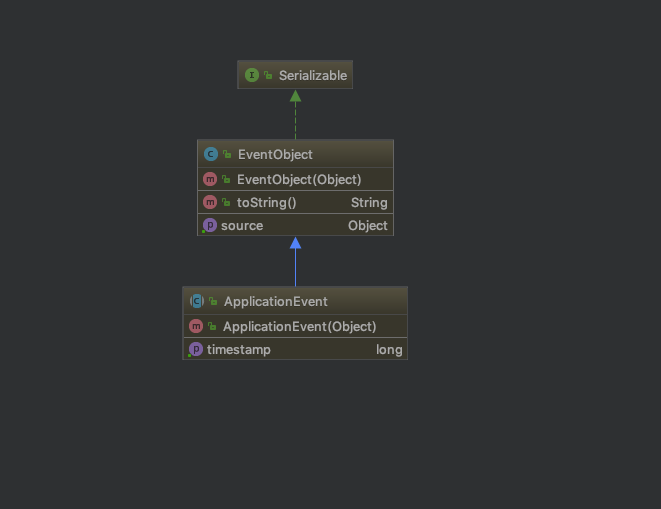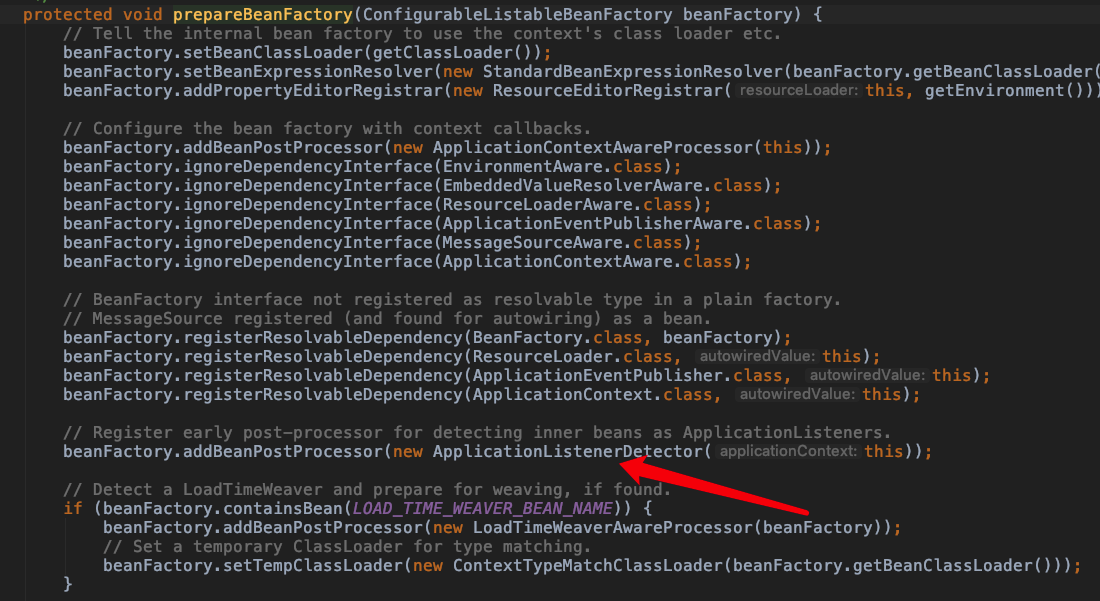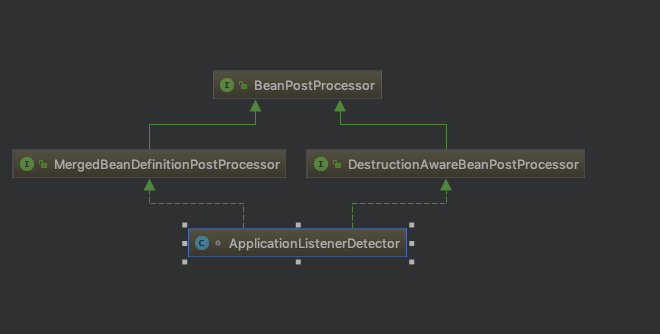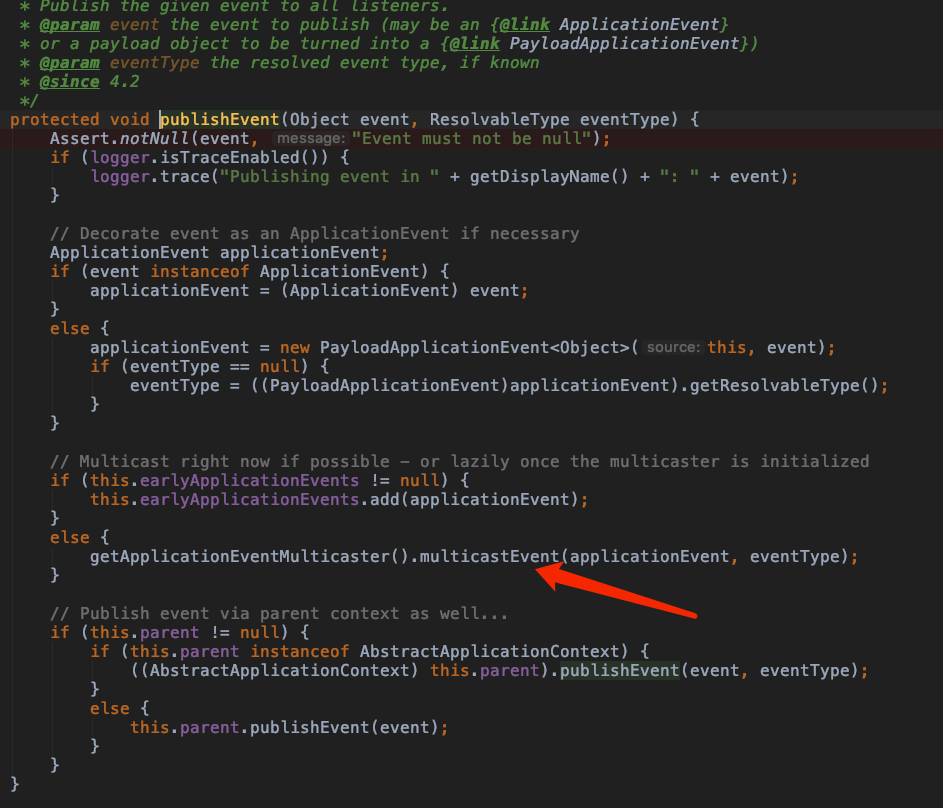深入理解Spring的容器內事件釋出監聽機制
目錄
1. 什麼是事件監聽機制
在講解事件監聽機制前,我們先回顧下設計模式中的觀察者模式,因為事件監聽機制可以說是在典型觀察者模式基礎上的進一步抽象和改進。我們可以在JDK或者各種開源框架比如Spring中看到它的身影,從這個意義上說,事件監聽機制也可以看做一種對傳統觀察者模式的具體實現,不同的框架對其實現方式會有些許差別。
典型的觀察者模式將有依賴關係的物件抽象為了觀察者和主題兩個不同的角色,多個觀察者同時觀察一個主題,兩者只通過抽象介面保持鬆耦合狀態,這樣雙方可以相對獨立的進行擴充套件和變化:比如可以很方便的增刪觀察者,修改觀察者中的更新邏輯而不用修改主題中的程式碼。但是這種解耦進行的並不徹底,這具體體現在以下幾個方面:
- 1.抽象主題需要依賴抽象觀察者,而這種依賴關係完全可以去除。
- 2.主題需要維護觀察者列表,並對外提供動態增刪觀察者的介面,
- 3.主題狀態改變時需要由自己去通知觀察者進行更新。
我們可以把主題(Subject)替換成事件(event),把對特定主題進行觀察的觀察者(Observer)替換成對特定事件進行監聽的監聽器(EventListener),而把原有主題中負責維護主題與觀察者對映關係以及在自身狀態改變時通知觀察者的職責從中抽出,放入一個新的角色事件釋出器(EventPublisher)中,事件監聽模式的輪廓就展現在了我們眼前,如下圖所示

常見事件監聽機制的主要角色如下
- 事件及事件源:對應於觀察者模式中的主題。事件源發生某事件是特定事件監聽器被觸發的原因。
- 事件監聽器:對應於觀察者模式中的觀察者。監聽器監聽特定事件,並在內部定義了事件發生後的響應邏輯。
- 事件釋出器:事件監聽器的容器,對外提供釋出事件和增刪事件監聽器的介面,維護事件和事件監聽器之間的對映關係,並在事件發生時負責通知相關監聽器。
Spring框架對事件的釋出與監聽提供了相對完整的支援,它擴充套件了JDK中對自定義事件監聽提供的基礎框架,並與Spring的IOC特性作了整合,使得使用者可以根據自己的業務特點進行相關的自定義,並依託Spring容器方便的實現監聽器的註冊和事件的釋出。因為Spring的事件監聽依託於JDK提供的底層支援,為了更好的理解,先來看下JDK中為使用者實現自定義事件監聽提供的基礎框架。
2. JDK中對事件監聽機制的支援
JDK為使用者實現自定義事件監聽提供了兩個基礎的類。一個是代表所有可被監聽事件的事件基類java.util.EventObject,所有自定義事件型別都必須繼承該類,類結構如下所示
public class EventObject implements java.io.Serializable {
private static final long serialVersionUID = 5516075349620653480L;
/**
* The object on which the Event initially occurred.
*/
protected transient Object source;
/**
* Constructs a prototypical Event.
*
* @param source The object on which the Event initially occurred.
* @exception IllegalArgumentException if source is null.
*/
public EventObject(Object source) {
if (source == null)
throw new IllegalArgumentException("null source");
this.source = source;
}
/**
* The object on which the Event initially occurred.
*
* @return The object on which the Event initially occurred.
*/
public Object getSource() {
return source;
}
/**
* Returns a String representation of this EventObject.
*
* @return A a String representation of this EventObject.
*/
public String toString() {
return getClass().getName() + "[source=" + source + "]";
}
}該類內部有一個Object型別的source變數,邏輯上表示發生該事件的事件源,實際中可以用來儲存包含該事件的一些相關資訊。
另一個則是對所有事件監聽器進行抽象的介面java.util.EventListener,這是一個標記介面,內部沒有任何抽象方法,所有自定義事件監聽器都必須實現該標記介面
/**
* A tagging interface that all event listener interfaces must extend.
* @since JDK1.1
*/
public interface EventListener {
}以上就是JDK為我們實現自定義事件監聽提供的底層支援。針對具體業務場景,我們通過擴充套件java.util.EventObject來自定義事件型別,同時通過擴充套件java.util.EventListener來定義在特定事件發生時被觸發的事件監聽器。當然,不要忘了還要定義一個事件釋出器來管理事件監聽器並提供釋出事件的功能。
2.1 基於JDK實現對任務執行結果的監聽
想象我們正在做一個關於Spark的任務排程系統,我們需要把任務提交到叢集中並監控任務的執行狀態,當任務執行完畢(成功或者失敗),除了必須對資料庫進行更新外,還可以執行一些額外的工作:比如將任務執行結果以郵件的形式傳送給使用者。這些額外的工作後期還有較大的變動可能:比如還需要以簡訊的形式通知使用者,對於特定的失敗任務需要通知相關運維人員進行排查等等,所以不宜直接寫死在主流程程式碼中。最好的方式自然是以事件監聽的方式動態的增刪對於任務執行結果的處理邏輯。為此我們可以基於JDK提供的事件框架,打造一個能夠對任務執行結果進行監聽的彈性系統。
- 任務結束事件的事件源
因為要對任務執行結束這一事件進行監聽,所以必須對任務這一概念進行定義,如下
/**
* @author: takumiCX
* @create: 2018-11-02
**/
@Data
public class Task {
private String name;
private TaskFinishStatus status;
}任務包含任務名和任務狀態,其中任務狀態是個列舉常量,只有成功和失敗兩種取值。
/**
* @author: takumiCX
* @create: 2018-11-02
**/
public enum TaskFinishStatus {
SUCCEDD,
FAIL;
}- 任務結束事件TaskFinishEvent
自定義事件型別TaskFinishEvent繼承自JDK中的EventObject,構造時會傳入Task作為事件源。
/**
* @author: takumiCX
* @create: 2018-11-02
**/
public class TaskFinishEvent extends EventObject {
/**
* Constructs a prototypical Event.
*
* @param source The object on which the Event initially occurred.
* @throws IllegalArgumentException if source is null.
*/
public TaskFinishEvent(Object source) {
super(source);
}
}- 該事件的監聽器抽象
繼承標記介面EventListner表示該介面的實現類是一個監聽器,同時在內部定義了事件發生時的響應方法onTaskFinish(event),接收一個TaskFinishEvent作為引數。
/**
* @author: takumiCX
* @create: 2018-11-02
**/
public interface TaskFinishEventListner extends EventListener {
void onTaskFinish(TaskFinishEvent event);
}- 郵件服務監聽器
該郵件服務監聽器將在監聽到任務結束事件時將任務的執行結果傳送給使用者。
/**
* @author: takumiCX
* @create: 2018-11-03
**/
@Data
public class MailTaskFinishListener implements TaskFinishEventListner {
private String emial;
@Override
public void onTaskFinish(TaskFinishEvent event) {
System.out.println("Send Emial to "+emial+" Task:"+event.getSource());
}
}- 自定義事件釋出器
/**
* @author: takumiCX
* @create: 2018-11-03
**/
public class TaskFinishEventPublisher {
private List<TaskFinishEventListner> listners=new ArrayList<>();
//註冊監聽器
public synchronized void register(TaskFinishEventListner listner){
if(!listners.contains(listner)){
listners.add(listner);
}
}
//移除監聽器
public synchronized boolean remove(TaskFinishEventListner listner){
return listners.remove(listner);
}
//釋出任務結束事件
public void publishEvent(TaskFinishEvent event){
for(TaskFinishEventListner listner:listners){
listner.onTaskFinish(event);
}
}
}- 測試程式碼如下
/**
* @author: takumiCX
* @create: 2018-11-03
**/
public class TestTaskFinishListener {
public static void main(String[] args) {
//事件源
Task source = new Task("使用者統計", TaskFinishStatus.SUCCEDD);
//任務結束事件
TaskFinishEvent event = new TaskFinishEvent(source);
//郵件服務監聽器
MailTaskFinishListener mailListener = new MailTaskFinishListener("[email protected]");
//事件釋出器
TaskFinishEventPublisher publisher = new TaskFinishEventPublisher();
//註冊郵件服務監聽器
publisher.register(mailListener);
//釋出事件
publisher.publishEvent(event);
}
}- 測試結果

如果後期因為需求變動需要在任務結束時將結果以簡訊的方式傳送給使用者,則可以再新增一個簡訊服務監聽器
/**
* @author: takumiCX
* @create: 2018-11-03
**/
@Data
@AllArgsConstructor
public class SmsTaskFinishListener implements TaskFinishEventListner {
private String address;
@Override
public void onTaskFinish(TaskFinishEvent event) {
System.out.println("Send Message to "+address+" Task:"+event.getSource());
}
}在測試程式碼中新增如下程式碼向事件釋出器註冊該監聽器
SmsTaskFinishListener smsListener = new SmsTaskFinishListener("123456789");
//註冊簡訊服務監聽器
publisher.register(smsListener);最後執行結果如下

基於JDK的支援要實現對自定義事件的監聽還是比較麻煩的,要做的工作比較多。而且自定義的事件釋出器也不能提供對所有事件的統一發布支援。基於Spring框架實現自定義事件監聽則要簡單很多,功能也更加強大。
3.Spring容器對事件監聽機制的支援
Spring容器,具體而言是ApplicationContext介面定義的容器提供了一套相對完善的事件釋出和監聽框架,其遵循了JDK中的事件監聽標準,並使用容器來管理相關元件,使得使用者不用關心事件釋出和監聽的具體細節,降低了開發難度也簡化了開發流程。下面看看對於事件監聽機制中的各主要角色,Spring框架中是如何定義的,以及相關的類體系結構
事件
Spring為容器內事件定義了一個抽象類ApplicationEvent,該類繼承了JDK中的事件基類EventObject。因而自定義容器內事件除了需要繼承ApplicationEvent之外,還要傳入事件源作為構造引數。

- 事件監聽器
Spring定義了一個ApplicationListener介面作為為事件監聽器的抽象,介面定義如下
public interface ApplicationListener<E extends ApplicationEvent> extends EventListener {
/**
* Handle an application event.
* @param event the event to respond to
*/
void onApplicationEvent(E event);
}1.該介面繼承了JDK中表示事件監聽器的標記介面EventListener,內部只定義了一個抽象方法onApplicationEvent(evnt),當監聽的事件在容器中被髮布,該方法將被呼叫。
2.同時,該介面是一個泛型介面,其實現類可以通過傳入泛型引數指定該事件監聽器要對哪些事件進行監聽。這樣有什麼好處?這樣所有的事件監聽器就可以由一個事件釋出器進行管理,並對所有事件進行統一發布,而具體的事件和事件監聽器之間的對映關係,則可以通過反射讀取泛型引數型別的方式進行匹配,稍後我們會對原理進行講解。
3.最後,所有的事件監聽器都必須向容器註冊,容器能夠對其進行識別並委託容器內真正的事件釋出器進行管理。
- 事件釋出器
ApplicationContext介面繼承了ApplicationEventPublisher介面,從而提供了對外發布事件的能力,如下所示

那麼是否可以說ApplicationContext,即容器本身就擔當了事件釋出器的角色呢?其實這是不準確的,容器本身僅僅是對外提供了事件釋出的介面,真正的工作其實是委託給了具體容器內部一個ApplicationEventMulticaster物件,其定義在AbstractApplicationContext抽象類內部,如下所示
/** Helper class used in event publishing */
private ApplicationEventMulticaster applicationEventMulticaster;所以,真正的事件釋出器是ApplicationEventMulticaster,這是一個介面,定義了事件釋出器需要具備的基本功能:管理事件監聽器以及釋出事件。其預設實現類是
SimpleApplicationEventMulticaster,該元件會在容器啟動時被自動建立,並以單例的形式存在,管理了所有的事件監聽器,並提供針對所有容器內事件的釋出功能。
3.1 基於Spring實現對任務執行結果的監聽
業務場景在2.1中已經介紹過了,這裡就不在囉嗦。基於Spring框架來實現對自定義事件的監聽流程十分簡單,只需要三部:1.自定義事件類 2.自定義事件監聽器並向容器註冊 3.釋出事件
- 1.自定任務結束事件
定義一個任務結束事件TaskFinishEvent2,該類繼承抽象類ApplicationEvent來遵循容器事件規範。
/**
* @author: takumiCX
* @create: 2018-11-04
**/
public class TaskFinishEvent2 extends ApplicationEvent {
/**
* Create a new ApplicationEvent.
*
* @param source the object on which the event initially occurred (never {@code null})
*/
public TaskFinishEvent2(Object source) {
super(source);
}
}- 2.自定義郵件服務監聽器並向容器註冊
該類實現了容器事件規範定義的監聽器介面,通過泛型引數指定對上面定義的任務結束事件進行監聽,通過@Component註解向容器進行註冊
/**
* @author: takumiCX
* @create: 2018-11-04
**/
@Component
public class MailTaskFinishListener2 implements ApplicationListener<TaskFinishEvent2> {
private String emial="[email protected]";
@Override
public void onApplicationEvent(TaskFinishEvent2 event) {
System.out.println("Send Emial to "+emial+" Task:"+event.getSource());
}
}- 3.釋出事件
從上面對Spring事件監聽機制的類結構分析可知,釋出事件的功能定義在ApplicationEventPublisher介面中,而ApplicationContext繼承了該介面,所以最好的方法是通過實現ApplicationContextAware介面獲取ApplicationContext例項,然後呼叫其釋出事件方法。如下所示定義了一個釋出容器事件的代理類
/**
* @author: takumiCX
* @create: 2018-11-04
**/
@Component
public class EventPublisher implements ApplicationContextAware {
private ApplicationContext applicationContext;
//釋出事件
public void publishEvent(ApplicationEvent event){
applicationContext.publishEvent(event);
}
@Override
public void setApplicationContext(ApplicationContext applicationContext) throws BeansException {
this.applicationContext=applicationContext;
}
}在此基礎上,還可以自定義一個簡訊服務監聽器,在任務執行結束時傳送簡訊通知使用者。過程和上面自定義郵件服務監聽器類似:實現ApplicationListner介面並重寫抽象方法,然後通過註解或者xml的方式向容器註冊。
4.Spring事件監聽原始碼解析
Spring事件監聽機制離不開容器IOC特性提供的支援,比如容器會自動建立事件釋出器,自動識別使用者註冊的監聽器並進行管理,在特定的事件釋出後會找到對應的事件監聽器並對其監聽方法進行回撥。Spring幫助使用者遮蔽了關於事件監聽機制背後的很多細節,使使用者可以專注於業務層面進行自定義事件開發。然而我們還是忍不住對其背後的實現原理進行一番探討,比如:
- 1.事件釋出器ApplicationEventMulticaster是何時被初始化的,初始化過程中都做了什麼?
- 2.註冊事件監聽器的過程是怎樣的,容器怎麼識別出它們並進行管理?
- 3.容器釋出事件的流程是怎樣的?它如何根據釋出的事件找到對應的事件監聽器,事件和由該事件觸發的監聽器之間的匹配規則是怎樣的?
為了對以上問題進行解答,我們不得不深入原始碼層面一探究竟。
4.1 初始化事件釋出器流程
真正的事件釋出器是ApplicationEventMulticaster,它定義在AbstractApplicationContext中,並在ApplicationContext容器啟動的時候進行初始化。在容器啟動的refrsh()方法中可以找到初始化事件釋出器的入口方法,如下圖所示

protected void initApplicationEventMulticaster() {
ConfigurableListableBeanFactory beanFactory = getBeanFactory();
// 判斷beanFactory裡是否定義了id為applicationEventMulticaster的bean,預設是沒有的
if (beanFactory.containsLocalBean(APPLICATION_EVENT_MULTICASTER_BEAN_NAME)) {
this.applicationEventMulticaster =
beanFactory.getBean(APPLICATION_EVENT_MULTICASTER_BEAN_NAME, ApplicationEventMulticaster.class);
if (logger.isDebugEnabled()) {
logger.debug("Using ApplicationEventMulticaster [" + this.applicationEventMulticaster + "]");
}
}
else {
//一般情況會走這裡,建立一個SimpleApplicationEventMulticaster並交由容器管理
this.applicationEventMulticaster = new SimpleApplicationEventMulticaster(beanFactory);
beanFactory.registerSingleton(APPLICATION_EVENT_MULTICASTER_BEAN_NAME, this.applicationEventMulticaster);
if (logger.isDebugEnabled()) {
logger.debug("Unable to locate ApplicationEventMulticaster with name '" +
APPLICATION_EVENT_MULTICASTER_BEAN_NAME +
"': using default [" + this.applicationEventMulticaster + "]");
}
}
}這裡會根據核心容器beanFactory中是否有id為applicationEventMulticaster的bean分兩種情況:
1.容器中已有id為applicationEventMulticaster的bean
直接從容器快取獲取或是建立該bean例項,並交由成員變數applicationEventMulticaster儲存。
當用戶自定義了事件釋出器並向容器註冊時會執行該流程。- 2.容器中不存在applicationEventMulticaster的bean
這是容器預設的執行流程,會建立一個SimpleApplicationEventMulticaster,其僅在實現事件釋出器基本功能(管理事件監聽器以及釋出容器事件)的前提下,增加了可以設定任務執行器
Executor和錯誤處理器ErrorHandler的功能,當設定Executor為執行緒池時,則會以非同步的方式對事件監聽器進行回撥,而ErrorHandler允許我們在回撥方法執行錯誤時進行自定義處理。預設情況下,
這兩個變數都為null。
public class SimpleApplicationEventMulticaster extends AbstractApplicationEventMulticaster {
private Executor taskExecutor;
private ErrorHandler errorHandler;public abstract class AbstractApplicationEventMulticaster
implements ApplicationEventMulticaster, BeanClassLoaderAware, BeanFactoryAware {
private final ListenerRetriever defaultRetriever = new ListenerRetriever(false);
final Map<ListenerCacheKey, ListenerRetriever> retrieverCache =
new ConcurrentHashMap<ListenerCacheKey, ListenerRetriever>(64);
private ClassLoader beanClassLoader;
private BeanFactory beanFactory;
private Object retrievalMutex = this.defaultRetriever;之後會呼叫beanFactory.registerSingleton方法將建立的SimpleApplicationEventMulticaster例項註冊為容器的單例項bean。
初始化事件釋出器的工作非常簡單,一句話總結:由容器例項化使用者自定義的事件釋出器或者由容器幫我們建立一個簡單的事件釋出器並交由容器管理。
4.2 註冊事件監聽器流程
註冊事件監聽器的流程在初始化事件釋出器之後,如下圖所示

其關鍵程式碼如下所示
// uninitialized to let post-processors apply to them!
//獲取實現ApplicationListener介面的所有bean的beanName
String[] listenerBeanNames = getBeanNamesForType(ApplicationListener.class, true, false);
for (String listenerBeanName : listenerBeanNames) {
//將監聽器的beanName儲存到事件釋出器中
getApplicationEventMulticaster().addApplicationListenerBean(listenerBeanName);
}首先遍歷beanFactory中所有的bean,獲取所有實現ApplicationListener介面的bean的beanName,並將這些beanName註冊到ApplicationEventMulticaster中
@Override
public void addApplicationListenerBean(String listenerBeanName) {
synchronized (this.retrievalMutex) {
//儲存所有監聽器的beanName
this.defaultRetriever.applicationListenerBeans.add(listenerBeanName);
//清除維護事件和監聽器對映關係的快取
this.retrieverCache.clear();
}
}defaultRetriever是定義在抽象類AbstractApplicationEventMulticaster中的成員,用來儲存所有事件監聽器及其beanName
private final ListenerRetriever defaultRetriever = new ListenerRetriever(false);其以內部類形式定義在AbstractApplicationEventMulticaster中
/**
* Helper class that encapsulates a specific set of target listeners,
* allowing for efficient retrieval of pre-filtered listeners.
* <p>An instance of this helper gets cached per event type and source type.
*/
private class ListenerRetriever {
//儲存所有事件監聽器
public final Set<ApplicationListener<?>> applicationListeners;
//儲存所有事件監聽器的beanName
public final Set<String> applicationListenerBeans;向事件釋出器註冊監聽器的beanName,其實就是將beanName加入ListenerRetriever的集合中。
其實看到這裡會有一個疑問,registerListeners()方法只是找到了所有監聽器的beanName並將其儲存到了事件釋出器ApplicationEventMulticaster中,那麼真正的事件監聽器例項是何時被建立並被加入到事件釋出器中的?
這裡我們不得不退回到啟動容器的refresh()方法中,在初始化beanFactory之後,初始化事件釋出器之前,容器在prepareBeanFactory(beanFactory)方法中又註冊了一些重要元件,其中就包括一個特殊的BeanPostProcessor:ApplicationListenerDetector,正如其類名暗示的那樣,這是一個事件監聽器的探測器。


該類實現了BeanPostProcessor介面,如下圖所示

ApplicationListenerDetector實現了BeanPostProcessor介面,可以在容器級別對所有bean的生命週期過程進行增強。這裡主要是為了能夠在初始化所有bean後識別出所有的事件監聽器bean並
將其註冊到事件釋出器中
@Override
public Object postProcessAfterInitialization(Object bean, String beanName) {
//判斷該bean是否實現了ApplicationListener介面
if (this.applicationContext != null && bean instanceof ApplicationListener) {
// potentially not detected as a listener by getBeanNamesForType retrieval
Boolean flag = this.singletonNames.get(beanName);
if (Boolean.TRUE.equals(flag)) {
// singleton bean (top-level or inner): register on the fly
//將實現了ApplicationListener介面的bean註冊到事件釋出器applicationEventMulticaster中
this.applicationContext.addApplicationListener((ApplicationListener<?>) bean);
}
else if (Boolean.FALSE.equals(flag)) {
if (logger.isWarnEnabled() && !this.applicationContext.containsBean(beanName)) {
// inner bean with other scope - can't reliably process events
logger.warn("Inner bean '" + beanName + "' implements ApplicationListener interface " +
"but is not reachable for event multicasting by its containing ApplicationContext " +
"because it does not have singleton scope. Only top-level listener beans are allowed " +
"to be of non-singleton scope.");
}
this.singletonNames.remove(beanName);
}
}
return bean;
}在初始化所有的bean後,該ApplicationListenerDetector的postProcessAfterInitialization(Object bean, String beanName)方法會被作用在每一個bean上,通過判斷傳入的bean
是否是ApplicationListener例項進行過濾,然後將找到的事件監聽器bean註冊到事件釋出器中。
3.4 容器事件釋出流程


這裡為了簡化原始碼閱讀的工作量,對一些細節和分支情形做了忽略,只考慮主流程,如上圖箭頭所示,這裡呼叫了事件釋出器的multicastEvent()方法進行事件釋出,需要傳入事件event和事件型別
eventType作為引數。不過通常這個eventType引數為null,因為事件的型別資訊完全可以通過反射的方式從event物件中獲得。繼續跟進原始碼
@Override
public void multicastEvent(final ApplicationEvent event, ResolvableType eventType) {
//獲取事件型別
ResolvableType type = (eventType != null ? eventType : resolveDefaultEventType(event));
//遍歷所有和事件匹配的事件監聽器
for (final ApplicationListener<?> listener : getApplicationListeners(event, type)) {
//獲取事件釋出器內的任務執行器,預設該方法返回null
Executor executor = getTaskExecutor();
if (executor != null) {
//非同步回撥監聽方法
executor.execute(new Runnable() {
@Override
public void run() {
invokeListener(listener, event);
}
});
}
else {
//同步回撥監聽方法
invokeListener(listener, event);
}
}
}首先通過傳入的引數或者通過呼叫resolveDefaultEventType(event)方法獲取事件的事件型別資訊,之後會通過
getApplicationListeners(event, type)方法得到所有和該事件型別匹配的事件監聽器,其實現邏輯後面會細說,這裡先跳過。對於匹配的每一個監聽器,視事件釋出器內是否設定了
任務執行器例項Executor,決定以何種方式對監聽器的監聽方法進行回撥。
- 若執行器例項Executor未設定,則進行同步回撥,即在當前執行緒執行監聽器的回撥方法
- 若使用者設定了Executor例項(通常而言是執行緒池),則會進行非同步回撥,監聽器的監聽方法會交由執行緒池中的執行緒去執行。
預設情況下容器不會為使用者建立執行器例項,因而對監聽器的回撥是同步進行的,即所有監聽器的監聽方法都在推送事件的執行緒中被執行,通常這也是處理業務邏輯的執行緒,若其中一個監聽器回撥執行
阻塞,則會阻塞整個業務處理的執行緒,造成嚴重的後果。而非同步回撥的方式,雖然不會導致業務處理執行緒被阻塞,但是不能共享一些業務執行緒的上下文資源,比如類載入器,事務等等。因而究竟選擇哪種回撥
方式,要視具體業務場景而定。
好了,現在可以來探究下困擾我們很久的一個問題了,那就是:如何根據事件型別找到匹配的所有事件監聽器?這部分邏輯在getApplicationListeners方法中
protected Collection<ApplicationListener<?>> getApplicationListeners(
ApplicationEvent event, ResolvableType eventType) {
//獲取事件中的事件源物件
Object source = event.getSource();
//獲取事件源型別
Class<?> sourceType = (source != null ? source.getClass() : null);
//以事件型別和事件源型別為引數構建一個cacheKey,用於從快取map中獲取與之匹配的監聽器列表
ListenerCacheKey cacheKey = new ListenerCacheKey(eventType, sourceType);
// Quick check for existing entry on ConcurrentHashMap...
ListenerRetriever retriever = this.retrieverCache.get(cacheKey);
if (retriever != null) {
//從快取中獲取監聽器列表
return retriever.getApplicationListeners();
}
if (this.beanClassLoader == null ||
(ClassUtils.isCacheSafe(event.getClass(), this.beanClassLoader) &&
(sourceType == null || ClassUtils.isCacheSafe(sourceType, this.beanClassLoader)))) {
// Fully synchronized building and caching of a ListenerRetriever
synchronized (this.retrievalMutex) {
retriever = this.retrieverCache.get(cacheKey);
if (retriever != null) {
return retriever.getApplicationListeners();
}
retriever = new ListenerRetriever(true);
//查詢所有與釋出事件匹配的監聽器列表
Collection<ApplicationListener<?>> listeners =
retrieveApplicationListeners(eventType, sourceType, retriever);
//將匹配結果快取到map中
this.retrieverCache.put(cacheKey, retriever);
return listeners;
}
}
else {
// No ListenerRetriever caching -> no synchronization necessary
return retrieveApplicationListeners(eventType, sourceType, null);
}
}整個流程可以概括為:
- 1.首先從快取map中查詢,這個map定義在事件釋出器的抽象類中
final Map<ListenerCacheKey, ListenerRetriever> retrieverCache =
new ConcurrentHashMap<ListenerCacheKey, ListenerRetriever>(64);ListenerCacheKey由事件型別eventType和事件源型別sourceType構成,ListenerRetriever內部則維護了一個監聽器列表。當所釋出的事件型別和事件源型別與Map中的key匹配時,
將直接返回value中的監聽器列表作為匹配結果,通常這發生在事件不是第一次釋出時,能避免遍歷所有監聽器並進行過濾,如果事件時第一次釋出,則會執行流程2。
- 2.遍歷所有的事件監聽器,並根據事件型別和事件源型別進行匹配。
Collection<ApplicationListener<?>> listeners =
retrieveApplicationListeners(eventType, sourceType, retriever);/**
* Actually retrieve the application listeners for the given event and source type.
* @param eventType the event type
* @param sourceType the event source type
* @param retriever the ListenerRetriever, if supposed to populate one (for caching purposes)
* @return the pre-filtered list of application listeners for the given event and source type
*/
private Collection<ApplicationListener<?>> retrieveApplicationListeners(
ResolvableType eventType, Class<?> sourceType, ListenerRetriever retriever) {
//這是存放匹配的監聽器的列表
LinkedList<ApplicationListener<?>> allListeners = new LinkedList<ApplicationListener<?>>();
Set<ApplicationListener<?>> listeners;
Set<String> listenerBeans;
synchronized (this.retrievalMutex) {
listeners = new LinkedHashSet<ApplicationListener<?>>(this.defaultRetriever.applicationListeners);
listenerBeans = new LinkedHashSet<String>(this.defaultRetriever.applicationListenerBeans);
}
//遍歷所有的監聽器
for (ApplicationListener<?> listener : listeners) {
//判斷該事件監聽器是否匹配
if (supportsEvent(listener, eventType, sourceType)) {
if (retriever != null) {
retriever.applicationListeners.add(listener);
}
//將匹配的監聽器加入列表
allListeners.add(listener);
}
}
//這部分可以跳過
if (!listenerBeans.isEmpty()) {
BeanFactory beanFactory = getBeanFactory();
for (String listenerBeanName : listenerBeans) {
try {
Class<?> listenerType = beanFactory.getType(listenerBeanName);
if (listenerType == null || supportsEvent(listenerType, eventType)) {
ApplicationListener<?> listener =
beanFactory.getBean(listenerBeanName, ApplicationListener.class);
if (!allListeners.contains(listener) && supportsEvent(listener, eventType, sourceType)) {
if (retriever != null) {
retriever.applicationListenerBeans.add(listenerBeanName);
}
allListeners.add(listener);
}
}
}
catch (NoSuchBeanDefinitionException ex) {
// Singleton listener instance (without backing bean definition) disappeared -
// probably in the middle of the destruction phase
}
}
}
//對匹配的監聽器列表進行排序
AnnotationAwareOrderComparator.sort(allListeners);
return allListeners;
}判斷監聽器是否匹配的邏輯在supportsEvent(listener, eventType, sourceType)中,
protected boolean supportsEvent(ApplicationListener<?> listener, ResolvableType eventType, Class<?> sourceType) {
//對原始的ApplicationListener進行一層介面卡包裝成為GenericApplicationListener
GenericApplicationListener smartListener = (listener instanceof GenericApplicationListener ?
(GenericApplicationListener) listener : new GenericApplicationListenerAdapter(listener));
//判斷監聽器是否支援該事件型別以及該事件源型別
return (smartListener.supportsEventType(eventType) && smartListener.supportsSourceType(sourceType));
}首先對原始的ApplicationListener進行一層介面卡包裝成GenericApplicationListener,便於後面使用該介面中定義的方法判斷監聽器是否支援傳入的事件型別或事件源型別
public interface GenericApplicationListener extends ApplicationListener<ApplicationEvent>, Ordered {
/**
* Determine whether this listener actually supports the given event type.
*/
boolean supportsEventType(ResolvableType eventType); //判斷是否支援該事件型別
/**
* Determine whether this listener actually supports the given source type.
*/
boolean supportsSourceType(Class<?> sourceType); //判斷是否支援該事件源型別
}smartListener.supportsEventType(eventType)用來判斷監聽器是否支援該事件型別,因為我們的監聽器例項通常都不是SmartApplicationListener型別,所以直接看下面箭頭所指的方法就好

declaredEventType是監聽器泛型的實際型別,而eventType是釋出的事件的型別
declaredEventType.isAssignableFrom(eventType)當以下兩種情況返回true
- 1.declaredEventType和eventType型別相同
- 2.declaredEventType是eventType的父型別
只要監聽器泛型的實際型別和釋出的事件型別一樣或是它的父型別,則該監聽器將被成功匹配。
而對於事件源型別而言,通常預設會直接返回true,也就是說事件源的型別通常對於判斷匹配的監聽器沒有意義。

這裡查詢到所有匹配的監聽器返回後會將匹配關係快取到retrieverCache這個map中
Collection<ApplicationListener<?>> listeners =
retrieveApplicationListeners(eventType, sourceType, retriever);
//將匹配結果快取到map中
this.retrieverCache.put(cacheKey, retriever);
return listeners;
梳理下容器事件釋出的整個流程,可以總結如下

5.總結
這篇文章主要是為了梳理下Spring的容器內事件體系並對其工作原理做一定程度上的原始碼上的剖析,本來還想展示一些關於Spring事件釋出監聽機制的一些擴充套件特性和額外功能,不過由於前面廢話太多導致篇幅
已經大大超出了預期,後面這部分只能有時間另開一篇再說了。
